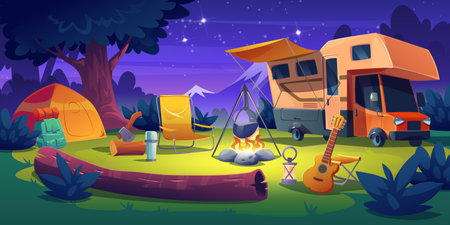1. Campfire Cooking Essentials
When it comes to camp cooking, having the right essentials can make or break your outdoor meal experience. Whether youre flipping pancakes at sunrise or grilling burgers under the stars, being prepared is key. Heres what every camper should pack before heading into the wild.
Must-Have Campfire Cooking Tools
Forget fancy kitchen gadgets—you just need a few reliable tools that can handle the heat and are easy to clean. Here’s a quick list of campfire cooking must-haves:
| Tool | Purpose | Why It Matters |
|---|---|---|
| Cast Iron Skillet | Searing, frying, baking | Durable, holds heat evenly, perfect for open flame |
| Grill Grate | Grilling meats and veggies | Elevates food above fire for even cooking |
| Long-Handled Tongs | Flipping and moving hot items | Keeps hands safely away from flames |
| Heat-Resistant Gloves | Handling hot pots and pans | Protects your hands from burns |
| Fireproof Spatula & Spoon | Stirring and serving food | Tough enough for high temperatures |
| Cowboy Coffee Pot or Kettle | Boiling water or making coffee/tea | Makes mornings in the woods much better! |
| Aluminum Foil & Dutch Oven | Baking and roasting over coals | Great for one-pot meals and easy cleanup |
| Roasting Sticks/Skewers | Cooking hot dogs, marshmallows, kebabs | A classic must-have for fun campfire meals |
| Cooler with Ice Packs | Keeping perishables fresh | Avoids food spoilage during your trip |
| Lighter or Waterproof Matches | Starting your campfire reliably every time | You cant cook without fire! |
Essential Gear Tips for Outdoor Cooking Success
- Go multipurpose: Choose gear that serves multiple functions to save space and weight.
- Pack smart: Use stackable containers and zip bags to organize ingredients and utensils.
- Prep at home: Chop veggies, marinate meats, and pre-mix dry ingredients before you leave.
- Use reusable supplies: Bring durable plates, cups, and silverware to reduce waste.
- Cleanup kit: Don’t forget biodegradable soap, sponges, trash bags, and paper towels.
- Potholders or trivets: Protect surfaces like picnic tables from hot cookware.
- Lid lifter or hook: Essential if you’re using a Dutch oven over coals.
- Campsite table or stand: Having a clean prep area makes cooking much easier.
- Headlamp or lantern: If youre cooking after dark, good lighting is a must.
- Tin foil packets (hobo meals): A simple way to cook full meals directly in the fire with minimal cleanup.
- Ziploc bags: Great for storing leftovers or keeping dry ingredients safe from moisture.
- Cup measuring set: Helpful when following recipes outdoors.
- Labeled spice kit: Pre-fill small containers with your favorite seasonings so you’re not stuck with bland food.
- Cork screw/bottle opener: You’ll thank yourself when it’s time to relax by the fire with a drink.
- Duct tape & multitool: For unexpected gear repairs on the go.
- Campsite-approved cutting board & knife: Essential for safe food prep in the wild.
- Squeeze bottles for oils & sauces: Easy to use and less messy than full-size bottles.
- Pie irons: Fun for making toasted sandwiches or desserts over the fire!
- Basting brush: Great for adding flavor while grilling meats or veggies.
- Campsite broom/dustpan: Keep your cooking area tidy—it helps prevent critters too!
- Smores kit box: Keep graham crackers, chocolate bars, and marshmallows organized for quick dessert action!
- Lid rest or hook: Keeps hot lids off dirty ground while cooking with cast iron or Dutch ovens.
- Splash guard/wind shield: Helps control flame when wind picks up around your fire pit or stove setup.
- Thermometer (meat-safe): Ensures your food is cooked properly—no guessing needed!
- Sustainable fuel source (if using portable stoves): Make sure it’s safe and approved where youre camping.
- Scent-proof storage bag/container: Keeps animals away from your food stash overnight!
- *Pro Tip:*
Avoid common rookie mistakes by testing your gear before hitting the campsite. Knowing how everything works will save time—and possibly dinner—once youre out there!
Your safety matters too!
No matter how delicious your campfire meal is shaping up to be, always remember basic fire safety. Build fires only in designated rings or pits, keep water nearby in case of emergencies, never leave flames unattended, and fully extinguish everything before bed. Food tastes better when everyone stays safe around the campfire!
2. Make-Ahead Meals and Prepping Tips
One of the best ways to make camp cooking easier is by doing as much prep work at home as possible. By preparing meals ahead of time, you’ll spend less time chopping veggies or washing dishes at the campsite and more time enjoying the great outdoors. Here are some practical tips and ideas to get you started:
Why Make-Ahead Meals Matter
Prepping your meals in advance can seriously cut down on campsite stress. You won’t have to deal with raw meat, limited space, or running water when everything is already chopped, marinated, or even fully cooked.
Simple Meal Prep Ideas
| Meal Type | Prep at Home | At the Campsite |
|---|---|---|
| Breakfast Burritos | Cook eggs, sausage, and veggies; wrap in tortillas and foil | Reheat over campfire or stove |
| Pasta Salad | Boil pasta, add veggies and dressing | Serve cold or room temp — no cooking needed |
| Skewers (Kabobs) | Chop meat & veggies, assemble on skewers, marinate | Grill over fire for a quick hot meal |
| Chili or Stew | Cook fully at home and store in airtight container | Reheat in a pot over the fire or stove |
Storage Tips for Prepped Food
- Use freezer bags: Save space and pack flat to keep your cooler organized.
- Label everything: Use a permanent marker to note what’s inside and when it was made.
- Freeze meals ahead: Frozen meals act like extra ice packs in your cooler and last longer.
- Avoid raw meat handling: Pre-cook meats when possible to reduce contamination risks.
Time-Saving Hacks
- Pre-chop ingredients: Onions, peppers, garlic—get them ready before you leave.
- Create spice mixes: Combine your favorite spices into small containers for easy use.
- Mason jar salads: Layer ingredients in jars for grab-and-go lunches.
- Pancake mix in a bottle: Mix dry ingredients with water in a squeeze bottle for no-mess breakfasts.
Pro Tip:
If youre camping for multiple days, plan meals that use overlapping ingredients. For example, bell peppers can go into breakfast scrambles, sandwiches at lunch, and kabobs for dinner. Less waste, less packing!
Your Camp Kitchen Starts at Home
The more you prep ahead of time, the smoother your outdoor cooking experience will be. With these easy make-ahead strategies, youll minimize cleanup and maximize fun on your next camping trip!

3. Creative Cooking Hacks and Tricks
Camping doesn’t mean sacrificing great meals—even if you’ve left most of your kitchen tools at home. With a little creativity, you can whip up delicious dishes using minimal gear. These out-of-the-box cooking tricks are perfect for campers who love good food but prefer to pack light.
Use Aluminum Foil Like a Pro
Aluminum foil is a campsite MVP. It’s lightweight, cheap, and incredibly versatile. Use it to make “hobo packs”—foil-wrapped meals cooked directly on the coals—or fashion makeshift pans and baking trays.
Quick Foil Meal Ideas:
| Meal | Main Ingredients | Cook Time (on coals) |
|---|---|---|
| Campfire Nachos | Tortilla chips, cheese, beans, jalapeños | 10 minutes |
| Foil Packet Breakfast | Eggs, hash browns, sausage | 15 minutes |
| Lemon Herb Fish | Fish fillet, lemon slices, herbs | 12–15 minutes |
Coffee Can Cooking
An old-school coffee can can double as a mini oven. Place hot coals around the base and inside the lid (if metal), and use it to bake biscuits or even small pizzas. Just be sure to use gloves when handling—it gets hot fast!
Mason Jar Shakers
No room for bulky spice racks? Pre-mix your favorite seasoning blends or pancake batter in mason jars before your trip. You can shake them up and pour with zero mess. Label each jar so youre not guessing what’s inside during meal prep.
Pancakes in a Squeeze Bottle
A clean ketchup or condiment squeeze bottle turns pancake-making into a no-fuss process. Pour your pre-made batter into the bottle at home and store it in your cooler. When it’s time for breakfast, just squeeze onto a skillet or griddle—less mess, more control.
Ditch the Grill—Try Rock Cooking
If there’s no grill available, heat up flat rocks near your campfire and cook directly on them. Make sure the rocks are dry and not from a riverbed (wet rocks can explode under high heat). This method works great for items like bacon, eggs, or tortillas.
Tuna Can Stove Hack
Create an emergency stove using a tuna can and cardboard soaked in wax. Light it up and place a small pot or pan on top for simple meals like boiling water or heating soup. Great for backpackers looking to save space.
Bake with an Orange Peel
This hack is as tasty as it is clever: hollow out an orange, fill it with cake or muffin batter, wrap in foil, and toss into the campfire coals. The citrus adds flavor while keeping the treat moist inside—a fun dessert surprise that doubles as entertainment for kids.
Simplify Cleanup with Silicone Liners
If you bring a Dutch oven or skillet, line it with silicone baking mats or parchment paper before cooking. It minimizes food sticking and makes cleanup way easier—just lift out the liner after eating.
Pro Tip:
If you’re using parchment paper over open flames or coals, keep temps below 425°F to prevent burning.
4. Efficient Food Storage and Organization
Keeping your ingredients fresh and your camp kitchen organized can make or break your outdoor cooking experience. When youre out in the wild, space is limited and convenience matters. Smart food storage not only saves time but also helps prevent waste and spoilage.
Use Clear, Stackable Containers
Opt for clear plastic containers with tight-fitting lids. They let you see whats inside without opening them and can be stacked to save valuable cooler or bin space.
Label Everything
Use waterproof labels or a permanent marker to label all your containers with contents and expiration dates. This keeps things easy to find and reduces food waste.
Prep at Home
Pre-chop veggies, marinate meats, and portion out snacks before you leave. Store them in zip-top bags or reusable silicone pouches to minimize mess at the campsite.
Storage Prep Ideas:
| Item | Storage Method | Tips |
|---|---|---|
| Vegetables | Chopped & stored in airtight bags | Add a paper towel to absorb moisture |
| Meat | Marinated in zip-top bags (frozen) | Freeze flat for faster thawing |
| Spices | Pill organizer or small jars | Label by name or meal use |
| Dry goods (rice, pasta) | Labeled mason jars or containers | Measure portions ahead of time |
Organize Your Cooler Like a Pro
A well-packed cooler keeps food colder longer and makes finding items easier. Use two coolers if possible—one for drinks and one for perishable food—to reduce frequent opening of the main food cooler.
Cooler Packing Tips:
- Layer smartly: Place items youll use last at the bottom.
- Use frozen water bottles: They act as ice packs and double as drinking water when melted.
- Avoid loose ice: Use block ice or ice packs to reduce sogginess.
- Keep it in the shade: Place your cooler under a tree or cover with a reflective blanket.
Create a Camp Kitchen Bin System
A set of labeled bins can turn your campsite into an efficient outdoor kitchen. Try organizing bins by category like cooking tools, dry pantry items, cleaning supplies, and utensils. This way, everything has its place and setup is quick every time you arrive at camp.
Suggested Bin Categories:
- Cooking Gear: Stove, fuel, pots, pans, utensils
- Pantry Items: Spices, oils, canned goods, snacks
- Cleaning Supplies: Dish soap, scrubbers, trash bags
- Dishes & Utensils: Plates, bowls, silverware, cups
The key to efficient camp cooking is preparation and organization. With these simple storage hacks, youll spend less time digging through gear and more time enjoying meals around the fire.
5. Kid-Friendly and Group Meal Ideas
Cooking for families or a big camping crew doesn’t have to be stressful. With a little planning, you can whip up delicious meals that satisfy picky eaters, kids, and hungry adults alike—without spending all day over the fire. Here are some fun, easy-to-cook ideas that make group meals simple and enjoyable.
Easy One-Pot Meals
One-pot meals are lifesavers when camping. They reduce cleanup time and are great for feeding multiple people. Try dishes like:
- Campfire Chili: Ground beef, canned beans, tomatoes, and chili seasoning cooked in one pot.
- Mac & Cheese with Hot Dogs: Use pre-cooked pasta and mix with shredded cheese and sliced hot dogs over medium heat.
- Sausage & Veggie Skillet: Sauté smoked sausage with chopped bell peppers, onions, and potatoes in a cast iron skillet.
Kid-Approved Campfire Snacks
Keep the little ones happy with treats they can help make:
- Crescent Roll-Ups: Wrap crescent dough around mini sausages or marshmallows and roast over the fire.
- Campfire Banana Boats: Slice open a banana (in the peel), stuff it with chocolate chips and mini marshmallows, wrap in foil, and heat over coals.
- DIY Trail Mix Bar: Set out bowls of nuts, dried fruit, cereal, pretzels, and chocolate candies so kids can create their own mix.
No-Fuss Breakfast Ideas
Mornings at camp can be busy. Keep breakfast simple but satisfying with these go-to options:
| Meal | Main Ingredients | Why It Works |
|---|---|---|
| Pancake Bites | Pancake mix, syrup, berries | Bake in muffin tins on grill or camp oven; easy to portion for kids |
| Breakfast Burritos | Tortillas, scrambled eggs, cheese, bacon or veggies | Make-ahead friendly and customizable for picky eaters |
| Yogurt Parfaits | Yogurt, granola, fruit | No cooking needed; healthy and fast for busy mornings |
Tips for Feeding a Crowd Around the Fire
- Prep Ahead: Chop veggies or marinate proteins at home to save time at the campsite.
- Create a Meal Station: Set up a table with ingredients so everyone can build their own meal (like tacos or sandwiches).
- Use Foil Packs: Let each camper fill their own foil pack with meat, veggies, and seasoning—then cook them all together on the fire.
The key is keeping things simple but tasty. With these kid-friendly and group meal hacks, you’ll spend less time cooking—and more time enjoying s’mores under the stars.


